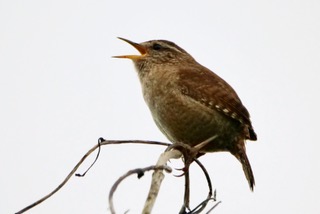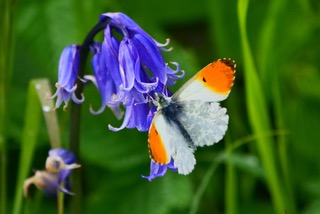 What to look out for in this month, once you have avoided being April fooled!
What to look out for in this month, once you have avoided being April fooled!
Look out for the Orange-tip butterfly, the first in Spring to emerge from its chrysalis, the male with those vivid, orange-tipped wings, flitting across gardens, with the female less conspicuous, so obviously a sign of Spring.
In dappled shady lanes and on woodland edges the Brimstone butterfly, with its completely yellow wings, dances in constant bouncy flight, rarely keeping still.
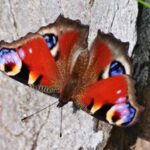
Look closely at nettles for the caterpillars of early Peacock butterflies and watch out for Small Tortoiseshell or Red Admiral butterflies, each of which you may already have seen on rare warm winter days.
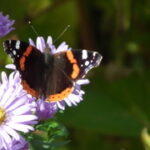
If you see a small blue butterfly in April, the likelihood is that it will be a Holly Blue. Other species to watch out for are the Speckled Wood, the Comma, the Small White and the Green-veined White butterflies.
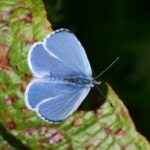
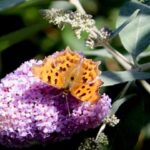
Primroses, and Cowslips too if you are lucky, astonish us with their delicate massed flowers on roadsides and field banks. Their chief pollinators are the butterflies I have already mentioned, together with the solitary bees and bee flies which are now so active.
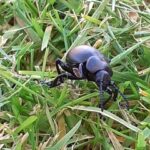 Ladybirds and Shieldbugs are seen more frequently too. Ground insects emerge, like the iridescent lumbering Oil Beetle or the well-named Bloody-nosed Beetle trundling along slowly across the still short vegetation on our lovely off-road footpaths.
Ladybirds and Shieldbugs are seen more frequently too. Ground insects emerge, like the iridescent lumbering Oil Beetle or the well-named Bloody-nosed Beetle trundling along slowly across the still short vegetation on our lovely off-road footpaths.
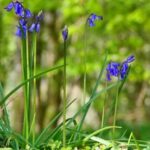 This is also the month for bluebells, an indicator of ancient woodland, so spectacular in their glorious drifts. See them at their best in places like Melinsey Valley, Messack Wood, Treluggan Cliff or Ruan Lanihorne Wood on the way to Tregony.
This is also the month for bluebells, an indicator of ancient woodland, so spectacular in their glorious drifts. See them at their best in places like Melinsey Valley, Messack Wood, Treluggan Cliff or Ruan Lanihorne Wood on the way to Tregony.
Incredibly, over half the world’s bluebells are found in the UK, always thriving where the soil or land has not been disturbed for centuries. Yet the plants themselves are fragile, taking between 5 and 7 years to grow from seed to flower. If damaged by our trampling feet, they do not recover, as the broken leaves cannot then photosynthesise.
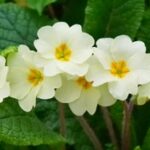 Like the primrose, cowslip, and other wild flowers, they are fully protected by the Wildlife and Countryside act. It is illegal to pick them, dig them up or intentionally destroy them. Their single nodding deep blue violet flowerheads, with such a beautiful scent, distinguish them from the invasive introduced Spanish bluebell, which have multiple upright flowers and no scent at all.
Like the primrose, cowslip, and other wild flowers, they are fully protected by the Wildlife and Countryside act. It is illegal to pick them, dig them up or intentionally destroy them. Their single nodding deep blue violet flowerheads, with such a beautiful scent, distinguish them from the invasive introduced Spanish bluebell, which have multiple upright flowers and no scent at all.
But there is scent in the air and the noise too of myriads of insects on the blossom of the early flowering trees. The Hazel catkins have been out for some time, but now they are joined by the white blossom on Blackthorn and the larger catkins of Alder, together with the pungent smell of Hawthorn blossom, all alive with the buzz of insects and the calls of birds.
As early as the first week in April the swallows return, having flown 6000 miles from South Africa, amazingly back to their original nest sites. Our major nesting birds are on territory, and each day the dawn chorus grows as they sing and call in this month, a precursor to their heightened chorus in May. See below for details about our Dawn Chorus walk.
Thanks to you all for supporting Wild Roseland,
David Hall
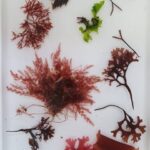
SEAWEED PRESSING EVENING
A seaweed pressing day was held on Friday 4th March.The day was sunny and warm with a very blue sea, just what we needed for collecting some small specimens of seaweed for our pressings. Our workshop took place in the little committee room at Gerrans Memorial Hall. Bunting hanging on the wall showed displays of seaweed information, for an introductory discussion on the importance of seaweeds and their role as indicators of climate change.
Our first priority was coffee and a chance to discuss our event donations, we felt passionately that they go to the Ukrainian refugees, so a transfer of £100 was gladly sent to the DEC Humanitarian Fund.
We walked to Tatam’s shore where at low tide we collected a few, smaller specimens of seaweeds. On returning to the workshop room they were placed in sea water in white trays, these enabled the unique characteristics of different species to show up well.
The chosen seaweed was floated in seawater and carefully lifted onto white paper or card placed under it. A paint brush is used to arrange the seaweed and display it in a way that shows its features well and as naturally as possible.
We inspected the various types of paper on offer to be used for the pressings, and watched a demo of the way to lift the seaweed onto the paper, out of the water and onto a flat surface, cover with a soft and (organic) nappy liner, a J-cloth and newspaper. Once the seaweed is safely within sheets of newspaper it can be transported home and put in a press if you have one, or under a pile of heavy books if not.
The object is to remove as much water as possible, over a week or so, leaving the seaweed high and dry but firmly embedded in the paper. The newspaper needs to be changed after a few days, so that the seaweed is as dry as possible.
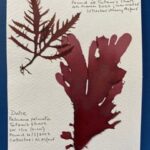
A recipe for the process, acquired from Plymouth’s Marine Biological Association, was available for everyone. Sandy (in true Blue Peter style) showed us several beautiful pressings she had made earlier. We were reminded to write with a pencil (before the floating) a note on the dry paper: collector’s name, date, location, name of seaweed, both the common and Latin name, assuming we could identify it. The recommended book for identifying seaweeds is “Seaweeds of Britain and Ireland”, by F Bunker, A Bunker, J Brodie and C Maggs. It’s now out of print (by Wild Nature Press), but available from World of Books.
The process can be as artistic or scientific as you like (or both) but all agreed the pressings make amazing artwork to show the hidden beauty of seaweeds.
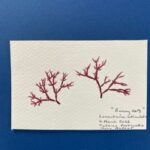
EVENT MAY 2022
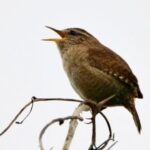
International Dawn Chorus
David Hall
Sunday, 1st May 2022, 4.45am
Messack
Numbers limited to 15 please contact David Hall (details below) if you would like to come along.
hallruan@aol.com
01872 501429
Acknowledgments to:
David Hall for the spring article
Chris Townsend for the seaweed pressing article
Photos:
Jane Lewarne, Orange-tip butterfly on Bluebell
David Hall, Peacock
Jane Lewarne, Red Admiral
Jane Lewarne, Holly Blue butterfly
Maggie Glass, Comma
Kate Gapper, Bloody-nosed beetle
Jane Lewarne, Bluebells
Jane Lewarne, Primrose
Chris Townsend, Seaweed photos

